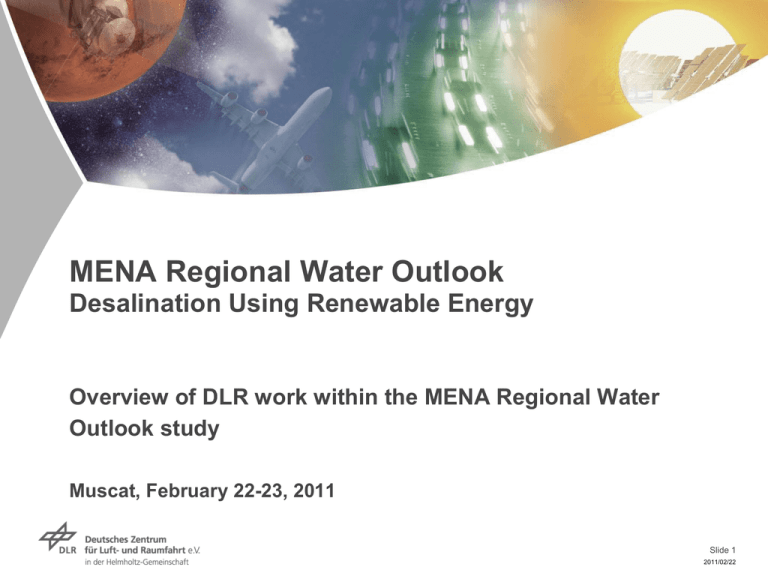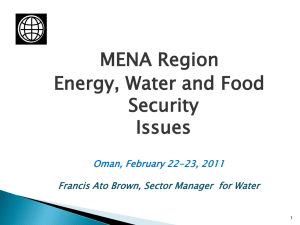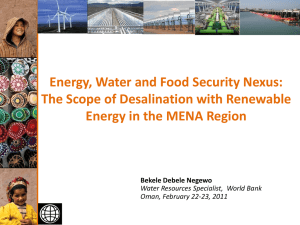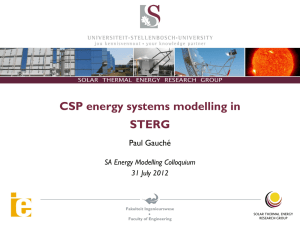DLR-Präsentation Allgemein mit Kopf
advertisement

MENA Regional Water Outlook Desalination Using Renewable Energy Overview of DLR work within the MENA Regional Water Outlook study Muscat, February 22-23, 2011 Slide 1 2011/02/22 Presentation overview 1. Applied Methodology 2. Desalination and renewable energy: The case of CSP • • CSP and Desalination: Introduction and Preliminary Considerations • Description of Typical Plant Configurations • Results Overview CSP Potential Assessment • • Methodology Results 3. The Scope of CSP in the MENA Region • • Electricity Supply Scenario Water Supply Scenario Slide 2 2011/02/22 Methodology Electricity Supply Scenario Special Focus on CSP! Configuration of typical CSP power plants Electricity Demand Model Electricity Supply Scenario for MENA Potential of other renewable energies in MENA Model Parameters - Replacement of old power plants - Maximum growth rates of renewable energy technologies -… CSP Potential in MENA Slide 3 2011/02/22 Methodology Water Supply Scenario Special Focus on CSP! Water Demand Model (by Future Water) Configuration of typical CSP + DES plants Water Supply Scenario for MENA Potential of other renewable energies in MENA Model Parameters - Replacement of old desalination plants - Maximum growth rates of renewable energy technologies -… CSP Potential in MENA Slide 4 2011/02/22 Desalination and renewable energy: The case of CSP CSP and Desalination: Introduction and Preliminary Considerations Massimo Moser, DLR Slide 5 2011/02/22 CSP Technology Overview www.dlr.de/desertec Slide 6 2011/02/22 Global Water Scarcity Source: IWMI 2006 Slide 7 2011/02/22 Global Potential for Concentrating Solar Power Source: REACCESS 2009 Slide 8 2011/02/22 Renewable energies for desalination: why CSP? Desalination plants require continuous operation This conflicts with the intermittent nature of renewable energies Storage of electricity is expensive CSP offers the option of thermal energy storage Hybrid operation is possible in the same power block (no “shadow power plant” required) Slide 9 2011/02/22 CSP Scheme Solar Field Fossil Back-up 395 °C Re-heater Steam Turbine 385 °C 377 °C 100 bar G Steam Generator 285 °C Temperature depends on the configuration Thermal Storage 295 °C Slide 10 2011/02/22 Methodology 1. Objective: preliminary analysis and comparison of different concentrating solar power and desalination plants Base idea for the comparison: all plants are designed to produce the same amount of electricity and water (100,000 m3/d water – ca. 115 MW electricity) 2. Land requirement assessment (input for potential assessment) 3. Preliminary plant design and LEC calculation (input for Desalination model) Slide 11 2011/02/22 CSP - MED 377 °C 16,5 bar 377 °C 100 bar G Sea 73 °C 0,35 bar Pre-treatment 1 2 3 4 Water intake 14 Brine discharge MED Slide 12 2011/02/22 CSP coast - RO Re-heater Steam Turbine 377 °C 100 bar G Permeate RO Brine Sea 40 - 50 °C Water intake Pre-treatment Once-Through Cooling Brine discharge Slide 13 2011/02/22 CSP inland - RO Re-heater Steam Turbine 377 °C 100 bar G Permeate 60 °C RO Brine Sea Brine discharge Pre-treatment Water intake Dry Cooling Slide 14 2011/02/22 Analyzed Configurations Desalination 100,000 m3/day Gross Power 110 – 120 MW Operation Base load (8,000 hours/y) Thermal Storage SM 2 (7.5 hours full load operation) Locations 1) Mediterranean Sea / Atlantic Ocean 2) Red Sea / Indian Ocean 3) Arabian Gulf Back-up fuel 1) Natural gas (NG): fuel factor 0.85 (Reference: crude oil price) 2) Heavy Fuel Oil (HFO): fuel factor 0.8 DNI 1) 2,000 kWh/m2/year coast site + 2,400 kWh/m2/year inland site 2) 2,400 kWh/m2/year coast site + 2,800 kWh/m2/year inland site Slide 15 2011/02/22 Results 1 – Investment Cost Slide 16 2011/02/22 Results 2 – Comparison of Configurations 120% 100% 80% MED/CSP RO/CSP + Once-Through Cooling RO/CSP + Dry Cooling RO/CSP + Dry Cool. + Solar Only 60% 40% 20% 0% Turbine Efficiency Internal El. Consumption Required Land Area LEC Assumptions: Location: Arabian Gulf; DNI: 2,400 kWh/m2/y; Fuel: NG Slide 17 2011/02/22 Desalination and renewable energy: The case of CSP CSP Potential Assessment Prepared by Tobias Fichter, DLR Slide 18 2011/02/22 CSP Potential in MENA Methodology: I. Solar Resource Assessment II. Land Resource Assessment III. CSP Potential IV. Statistical Evaluation Technical CSP Potential in MENA - Case Total Electricity Potential [TWh/y] 80000 70000 60000 50000 40000 30000 20000 10000 0 1800 1900 2000 2100 2200 2300 2400 2500 2600 2700 2800 2900 3000 DNI [kWh/m²/y] Slide 19 2011/02/22 CSP Potential MENA Solar Resource Assessment: Direct Normal Irradiation (DNI) is the energy resource for CSP power plants DLR method models the optical transparency of the atmosphere to calculate the DNI DNI data calculated for the year 2002 spatial resolution: 30 arc seconds (~ 1 x 1 km) DNI data calculated for all MENA countries except of Djibouti and Iran For Djibouti data from NREL For Iran data from NASA Slide 20 2011/02/22 CSP Potential in MENA Land Ressource Assessment: Exclusion Criteria for CSP Plants Terrain Slope > 2,1% Land Cover Post-flooding or irrigated croplands (or aquatic) Rainfed croplands Mosaic cropland / vegetation Forest (>5m) … Population Density Population density > 50 persons per km² Hydrology Lake Reservoir River Freshwater Marsh, Floodplain … Geomorphology Shifting Sand, Dunes Security Zone for Shifting Sands 10km Salt Pans … Protected Area IUCN Ia IUCN Ib IUCN II … Infrastructure Airports Security Zone for Airports 5km Desalination plants (capacity > 50,000 m³/day) Security Zone for Desalination Plants 0.5 km Project related exclusion criteria Suitable area < 4km² Distance from shore (onshore) > 5km … Compulsive Optional Cases Total Coast x x x x x x x x x x x x x x x x x x x x x x x x x x x x x x x x x x x x x x x x x x x x x x x x x x x x x x x x x x x x x x x Definition of land exclusion criteria Two Cases: - Total & Coast Different land exclusion criteria for the cases Main exclusion criteria categories: - Terrain - Land cover - Hydrology - Geomorphology - Protected areas - Infrastructure - Project related criteria Slide 21 2011/02/22 CSP Potential in MENA Land Resource Assessment: Overlay Analysis Creating of land exclusion layers with high spatial resolution (~1 x 1km) using geographic information systems (GIS) Combining layers for total land exclusion map Result: Suitable areas for CSP Slide 22 2011/02/22 CSP Potential in MENA CSP Potential Map Combining data from solar resource assessment and land resource assessment Results: Annual sum of DNI on areas which are suitable for CSP power plants Slide 23 2011/02/22 CSP Potential in MENA Results: Detailed CSP potential maps for each country Statistical evaluation for each country Example: Oman (case Total) Technical Potential - Case: Total 6000 Electricity Potential [TWh/y] 5000 4000 3000 2000 1000 0 1800 1900 2000 2100 2200 2300 2400 2500 2600 2700 2800 2900 3000 DNI [kWh/m²/y] Slide 24 2011/02/22 Technical Potential - Case: Coast CSP Potential in MENA Detailed near-shore CSP potential maps for each country Statistical evaluation for each country Example: Oman (case Coast) 35.000 Electricity Potential [TWh/y] Results: 40.000 30.000 25.000 20.000 15.000 10.000 5.000 0.000 1800 1900 2000 2100 2200 2300 2400 2500 2600 2700 2800 2900 DNI [kWh/m²/y] Slide 25 2011/02/22 3000 Google Earth overlay for site assessment Slide 26 2011/02/22 CSP Potential in MENA Input for Electricity and Water Supply Scenarios CSP potential for electricity generation of each MENA country Total Algeria Bahrain Djibouti* Egypt Gaza Strip & Westbanks Iran* Iraq Israel Jordan Kuwait Lebanon Libya Malta Morocco Oman Qatar Saudi Arabia Syria Tunisia United Arab Emirates Yemen Total Coast Technical Potential Economical Potential Technical Potential Economical Potential [TWh/y] [TWh/y] [TWh/y] [TWh/y] [DNI > 1800 kWh/m²/y] [DNI > 2000 kWh/m²/y] [DNI > 1800 kWh/m²/y] [DNI > 2000 kWh/m²/y] 135823 135771 0.3 0 16 16 9 9 372 300 0 0 57143 57140 74 74 8 8 0 0 32597 32134 267 267 27719 24657 0 0 151 151 2 2 5885 5884 0 0 1372 1372 18 18 5 5 0 0 82727 82714 135 132 0 0 0 0 8463 8428 15 15 15460 14174 84 84 696 555 56 43 76318 75832 152 152 9616 8449 1 1 5762 5673 58 49 493 447 15 15 11432 8486 108 104 472057 462196 995 964 Slide 27 2011/02/22 The Scope of CSP in the MENA Region Electricity and Water Supply Scenarios Franz Trieb, DLR Slide 28 2011/02/22 Power Scenario Methodology 1. power demand from 2000 to 2050 2. economic renewable energy potential for power generation 3. life cycle of old power plants opens opportunity for replacement 4. share of power technologies on firm capacity 125% availability 5. performance (load factor) of each technology 6. sustainable: secure, inexpensive, compatible 7. well balanced mix of fluctuating and storable sources 8. no technical break through required Slide 29 2011/02/22 Electricity Consumption of all MENA Countries Gross Electricity Consumption [TWh/a] 3500 3000 start of scenario + 300 million people + economic growth + efficiency 1990 2010 2500 2000 1500 1000 500 0 1980 2000 2020 2030 2040 2050 Yemen UAE Tunisia Syria Saudi Arabia Qatar Palestine Oman Morocco Malta Libya Lebanon Kuwait Jordan Israel Iraq Iran Egypt Djibouti Bahrain Algeria Year Slide 30 2011/02/22 Renewable Electricity Potential in Europe, Middle East & North Africa Biomass (0-1) Geothermal (0-1) Solar (10-250) Max Min Wind Energy (5-50) Hydropower (0-50) Electricity Yield in GWh/km²/y Slide 31 2011/02/22 Renewable Power Generation Potential by Sources in TWh/y Algeria Bahrain Djibouti Egypt Gaza & WB Iran Iraq Israel Jordan Kuwait Lebanon Libya Malta Morocco Oman Qatar Saudi Arabia Syria Tunisia UAE Yemen Total Hydro 0.5 0.0 0.0 50.0 0.0 48.0 67.0 7.0 0.1 0.0 1.0 0.0 0.0 4.0 0.0 0.0 0.0 4.0 0.5 0.0 0.0 182 Geo 4.7 0.0 0.0 25.7 0.0 11.3 0.0 0.0 0.0 0.0 0.0 0.0 0.0 10.0 0.0 0.0 70.9 0.0 3.2 0.0 107.0 233 Bio 12.3 0.2 0.0 14.1 1.7 23.7 8.8 2.3 1.6 0.8 0.9 1.8 0.1 14.3 1.1 0.2 10.0 4.7 3.2 0.7 9.1 111 CSP 135771 16 300 57140 8 32134 24657 151 5884 1372 5 82714 0 8428 14174 555 75832 8449 5673 447 8486 462196 Wind 35.0 0.1 1.0 125.0 0.5 12.0 20.0 0.5 5.0 n.a. 1.0 15.0 0.2 35.0 8.0 n.a. 20.0 15.0 8.0 n.a. 3.0 304 PV * 20.9 0.5 50.0 54.0 20.0 54.0 34.6 6.0 6.7 3.8 5.0 7.8 0.2 17.0 4.1 1.5 20.8 17.3 3.7 9.0 19.3 356 Source: www.dlr.de/tt/med-csp Slide 32 2011/02/22 Criteria for Sustainable Electricity Supply: Inexpensive low electricity cost no long term subsidies Secure diversified and redundant supply power on demand based on inexhaustible resources available or at least visible technology capacities expandable in time Compatible low pollution climate protection low risks for health and environment fair access Slide 33 2011/02/22 Portfolio of Energy Sources for Electricity: Coal, Lignite Oil, Gas Nuclear Fission, Fusion Concentrating Solar Power (CSP) Geothermal Power (Hot Dry Rock) Biomass Hydropower Wind Power Photovoltaic Wave / Tidal ideally stored primary energy storable primary energy fluctuating primary energy Slide 34 2011/02/22 Electricity Production of all MENA Countries by Sources 3500 Electricity Production (TWh/y) 3000 Photovoltaics Wind Geothermal Hydropower Biomass CSP Plants Oil Gas Coal Nuclear 2500 2000 1500 1000 500 0 2000 2010 2020 2030 2040 2050 Year Slide 35 2011/02/22 Installed Capacity (GW) Installed Capacity in all MENA Countries by Sources 1000 1000 900 900 800 800 700 700 600 600 500 500 400 400 300 300 200 200 100 100 0 2000 2010 2020 2030 2040 0 2050 260 GW fluctuating! Photovoltaics Wind Geothermal Hydropower Biomass CSP Plants Oil / Gas Coal Nuclear Peak Load Year Slide 36 2011/02/22 CO2- Emissions from Power Generation by Sources 1600 Carbon Emissions (Mt/y) 1400 1200 1000 Wind Photovoltaics Geothermal Biomass CSP Plants Hydropower Oil Gas Coal Nuclear t/GWh 12 70 80 68 17 17 700 450 800 65 Avoided Photovoltaics Wind Geothermal Hydropower Biomass CSP Plants Oil Gas Coal Nuclear 800 600 400 200 0 2000 2010 2020 2030 2040 2050 Year Slide 37 2011/02/22 Why CSP for Power in MENA? 1. CSP provides balancing power on demand for base, medium or peak load 2. MENA has no potential for pump storage like Europe to compensate fluctuations from wind and PV 3. storable hydropower, biomass and geothermal are very limited in MENA 4. CSP potential in MENA is extremely large and domestic 5. CSP combines ideally with natural gas and fuel oil Slide 38 2011/02/22 Water Scenario Methodology 1. water demand from 2000 to 2050 2. total and coastal CSP potential for desalination 3. life cycle of old desal plants opens opportunity for replacement 4. top priority for efficiency gains 5. second priority for reuse of waste water 6. third priority for sustainable surface and ground water extractions 7. fourth priority for existing and planned conventional desal plants 8. last priority for CSP desalination after 2015 9. no priority for unsustainable water extractions Slide 39 2011/02/22 Middle East & North Africa (MENA) 500,000 Water Production [MCM/y] 450,000 400,000 Year Efficiency Gains Unsustainable Extractions CSP Desalination Conventional Desalination Wastewater Reuse Surface Water Extractions Groundwater Extractions Total Demand BaU 2000 2010 2020 2030 2040 2050 0 0 17,655 35,959 57,108 80,036 32,432 47,015 44,636 9,104 7,093 16,589 0 0 23,405 55,855 79,461 97,658 4,598 9,210 12,679 9,732 1,054 0 4,445 4,929 16,965 29,618 44,125 60,357 185,256 172,975 146,749 162,131 165,735 150,024 39,136 43,051 48,116 41,491 36,032 37,700 265,868 277,180 310,205 343,891 390,609 442,364 500,000 450,000 400,000 350,000 350,000 Efficiency Gains 300,000 300,000 Unsustainable Extractions 250,000 250,000 200,000 200,000 Wastewater Reuse 150,000 150,000 Surface Water Extractions 100,000 100,000 50,000 50,000 0 2000 2010 2020 2030 Year 2040 CSP Desalination Conventional Desalination Groundwater Extractions Total Demand BaU 0 2050 Average Climate Change Slide 40 2011/02/22 600,000 600,000 600,000 600,0 500,000 500,000 500,000 500,0 400,000 Arabian Peninsula 80,000 80,000 70,000 70,000 60,000 60,000 300,000 Efficiency Gains 200,000 50,000 50,000 40,000 CSP Desalination Wastewater Reuse Surface Water Extractions 20,000 10,000 10,000 2030 2010 2020 0 2050 2020 2040 400,000 400,000 Efficiency Gains 400,0 Unsustainable Extractions 300,000 300,000 CSP Desalination 300,0 Conventional Desalination 200,000 200,000 Wastewater Reuse 200,0 Natural Water Used Conventional Desalination 30,000 20,000 0 0 2000 2000 2010 Unsustainable Extractions 40,000 30,000 100,000 Water Production [MCM/y] Water Production [MCM/y] Water Production [MCM/y] AQUA-CSP: Middle & NorthMiddle AfricaEast (MENA) & North Africa (MEN AQUA-CSP Scenario vs. EastMENA Water Outlook 100,000 100,000 100,0 Total Demand BaU Groundwater Extractions Total Demand BaU 2030 2040 0 2050 0 2000 2010 2020 2030 2040 0 2050 Year Year Year constant reduced per capita water for irrigation Source: www.dlr.de/tt/aqua-csp Slide 41 2011/02/22 Water Production [MCM/y] North Africa 160,000 160,000 140,000 140,000 120,000 120,000 Efficiency Gains 100,000 100,000 80,000 80,000 60,000 60,000 Unsustainable Extractions CSP Desalination Conventional Desalination Wastewater Reuse Surface Water Extractions 40,000 40,000 20,000 20,000 0 2000 2010 2020 2030 2040 Groundwater Extractions Total Demand BaU 0 2050 Year Slide 42 2011/02/22 Water Production [MCM/y] Western Asia 250,000 250,000 200,000 200,000 Efficiency Gains 150,000 150,000 Unsustainable Extractions CSP Desalination Conventional Desalination 100,000 100,000 Wastewater Reuse Surface Water Extractions 50,000 0 2000 50,000 2010 2020 2030 2040 Groundwater Extractions Total Demand BaU 0 2050 Year Slide 43 2011/02/22 Water Production [MCM/y] Arabian Peninsula 80,000 80,000 70,000 70,000 60,000 60,000 Efficiency Gains 50,000 50,000 40,000 40,000 30,000 30,000 Unsustainable Extractions CSP Desalination Conventional Desalination Wastewater Reuse Surface Water Extractions 20,000 20,000 10,000 10,000 0 2000 2010 2020 2030 2040 Groundwater Extractions Total Demand BaU 0 2050 Year Slide 44 2011/02/22 Results of Water Scenarios Algeria Bahrain Djibouti Egypt Gaza Iran Iraq * Israel Jordan * Kuwait Lebanon Libya Malta Morocco Oman Qatar Saudi Arabia Syria Tunisia UAE West Bank Yemen Total Total CSP CSP Coastal CSP CSP-SWD Potential Demand 2050 Potential Demand 2050 TWh/y TWh/y TWh/y TWh/y 135771 120 0.0 7.5 16 4 8.6 1.3 300 1 0.0 0.0 57140 395 73.9 25.5 0 0 0.0 1.5 32134 290 267.4 37.0 24657 180 0.0 57.1 151 29 1.7 15.4 5884 38 0.0 5.7 1372 13 17.6 2.9 5 5 0.0 1.2 82714 25 132.3 9.9 0 0 0.0 0.3 8428 110 14.8 29.9 14174 14 83.5 7.1 555 8 43.2 1.8 75832 135 152.4 101.7 8449 117 0.5 3.1 5673 34 48.7 9.2 447 40 14.9 10.3 8 8 0.0 2.3 8486 65 104.0 49.7 462196 1630 964 380 CSP Potential < SWD Demand 2050 Power Demand kWh/m³ 3.5 4.3 4.3 3.8 3.5 3.5 4.3 3.5 3.8 4.3 3.5 3.5 3.5 3.5 3.5 4.3 4.3 3.5 3.5 4.3 3.0 3.8 3.9 RO only Supply 2050 BCM/y 2.1 0.0 0.0 0.0 0.0 0.0 13.3 4.0 1.5 0.0 0.1 0.0 0.0 5.3 0.0 0.0 0.0 0.8 0.0 0.0 0.0 0.0 27 RO or MED Supply 2050 BCM/y 0.0 0.3 0.0 6.7 0.0 10.6 0.0 0.4 0.0 0.7 0.0 2.8 0.0 3.3 2.0 0.4 23.7 0.1 2.6 2.4 0.0 13.1 69 CSP-SWD Demand 2050 BCM/y 2.1 0.3 0.0 6.7 0.4 10.6 13.3 4.4 1.5 0.7 0.3 2.8 0.1 8.5 2.0 0.4 23.7 0.9 2.6 2.4 0.8 13.1 98 Total Water Demand 2050 BCM/y 13.6 0.4 0.1 92.6 0.6 114.9 74.2 6.4 2.5 1.3 1.9 6.2 0.2 26.1 3.1 0.6 37.2 25.3 6.5 3.3 1.2 24.2 442 Coastal CSP Potential < SWD Demand 2050 Coastal CSP Potential > SWD Demand 2050 Slide 45 2011/02/22 Yemen West Bank UAE Tunisia Syria 23.7 Saudi Arabia Qatar Oman Morocco Malta RO or MED RO only Libya Lebanon Kuwait Jordan * Israel Iraq * Iran Gaza Egypt Djibouti Bahrain Algeria 0 2 4 6 8 10 12 14 CSP Desalination Potential [Bm³/y] Slide 46 2011/02/22 Why CSP for Water in MENA? 1. CSP potential is very large even at coastal sites 2. good seasonal correlation of availability and demand 3. most abundant in regions with highest water scarcity 4. base load for uninterrupted operation of desalination plants 5. solar powered pre-treatment replaces chemicals Slide 47 2011/02/22 Electricity Cost ($2010 /kWh) 0.35 Cost of CSP at DNI 2400 kWh/m²/a 0.30 Peak Load Cost 0.25 B1 0.20 Medium Load Cost B2 0.15 B Base Load Cost 0.10 B3 0.05 0.00 2010 Average Cost without CSP 2020 2030 2040 2050 Year www.dlr.de/tt/csp-finance Break Even with different load segments Slide 48 2011/02/22 0.12 Case 1: 100% Substitution in peak and medium load segment by CSP a LCOE ($2010/kWh) 0.11 Average LCOE without CSP 0.10 b 0.09 Average LCOE with CSP c Average LCOE with Peak CSP 0.08 0.07 2010 2020 2030 2040 2050 Year Slide 49 2011/02/22 How to finance CSP 1. identify real structure of national power generation cost 2. calculate CSP cost and learning curve under local conditions 3. compare and identify evtl. break even points 4. offer PPA (and WPA) as required 5. call for offers on best quality and longevity for the capacity needed 6. provide national and international guarantee on PPA 7. connect PPA to loan period 8. transparent scheme, quick procedures Slide 50 2011/02/22 Thank You! Slide 51 2011/02/22







